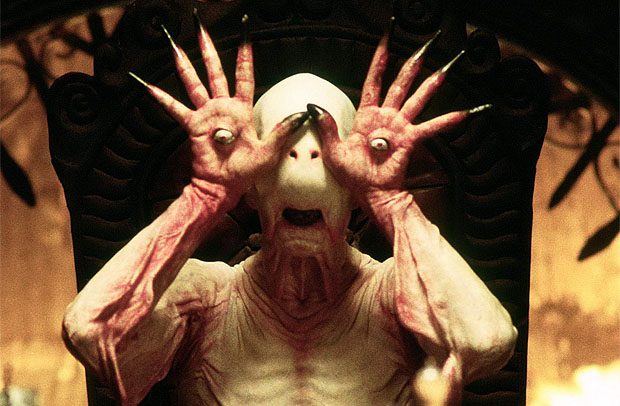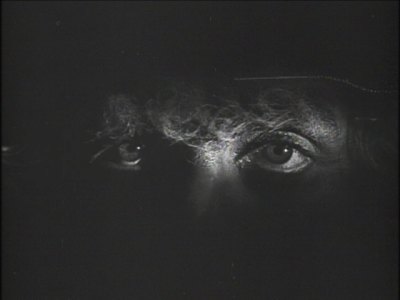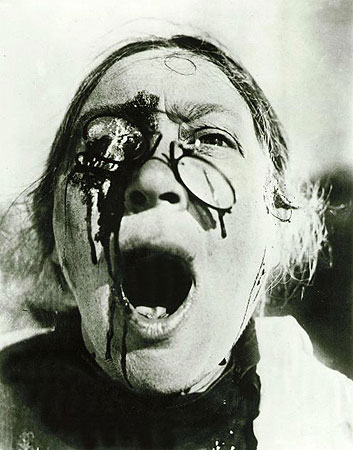
A film is never really any good unless the camera is an eye in the head of a poet

Pupil, from the Latin pupilla, 'a little doll'. When the Romans looked into one another's eyes they saw a doll-like reflection of themselves. The old Hebrew expression for pupil is similar: eshon ayin, which means 'little man of the eye'

To me, one of the cardinal sins for a scriptwriter, when he runs into some difficulty, is to say ‘We can cover that by a line of dialogue.’ Dialogue should simply be a sound among sounds, just something that comes out of the mouths of people whose eyes tell the story in visual terms.

There are many explanations for what inspired the legend of the Cyclopes - the one-eyed monsters of classical mythology - invoking everything from an ancient find of mysterious dwarf elephant skulls, to the blacksmith's habit, in the days before protective goggles, of protecting one eye with a patch. But the most likely inspiration is also the saddest; occasionally a human cyclops survives in the womb long enough to emerge visibly disfigured. Once upon a time, someone got a good look at what they had aborted - and for ever after wished they hadn't

In the early 50s two research teams stumbled independently on a way to stabilise images on the retina. They fastened tiny spotlights to the contact lenses their volunteers wore. It didn't matter how much the volunteers moved their eyes: the little spots of light would always be stabilised at exactly the same places on the retinas. The results could not have been more spectacular: after about a second of this curious, frozen vision, the volunteers lost sight of the lights. The eye exists to detect movement. Any image, perfectly stabilised on the retina, vanishes. Our eyes cannot see stationary objects, and must tremble constantly to bring them into view.

Dr. Mabuse is a master of disguise like Fantômas and a master of telepathic hypnosis, not unlike the hypnotist Dr. Caligari. Like Fu Manchu, Mabuse commits very few of his crimes in person, instead operating primarily through a network of agents acting out schemes he has laid down for them. Mabuse's agents range from career criminals following him for money, to innocents blackmailed or hypnotized into cooperation, to dupes so successfully manipulated they do not realize that they are doing exactly what Mabuse planned for them to do

Both Peeping Tom and Vertigo preface their narratives with the extreme close-up of an eye, as if to announce at once the themes of vision and subjectivity. In Peeping Tom we can detect, below the closed lid, the rapid eye movement that denotes dreaming; the eye thereupon opens wide, introducing a story that has the intensity and condensed logic of dream, or nightmare

As Vertigo's credits begin, the camera moves across the face of an unidentified woman. After first framing the mouth, it moves up to a close-up of the right eye, which opens wide, as if in shock; then moves further in, as if into its interior depths, from which galaxy-like spirals emerge.

Our eyes see very little and very badly – so people dreamed up the microscope to let them see invisible phenomena; they invented the telescope…now they have perfected the cinecamera to penetrate more deeply into he visible world, to explore and record visual phenomena so that what is happening now, which will have to be taken account of in the future, is not forgotten.

No one knows how we focus our attention. No one even knows how to ask the right questions. If the eye is an outpost of the brain, it is - by the same logic - an incursion of the light. When our eyes are drawn to a change in the scene, what draws them: our desire to see, or the change in the scene? Is one a cause, the other an effect? Or - in Goethe's memorable phrase - do 'the two together constitute the indissoluble phenomenon'?

Stand about eight to ten inches from a mirror and look at your left eye. Now look at your right eye, and then back at your left eye. Do this five or six times in quick succession. You will not notice any movement - your eyes will seem to be completely still. But this is in fact not the case, as an observant friend will immediately tell you: your eyes move quite a lot with each shift of focus. The blurred swish during the movement of the eye is somehow snipped from our conscious awareness, and we are left with just the significant images before and after the movement. Not only do we not see the blurred movement, we are unaware that anything has been removed. And this is happening all the time: with every movement of our eyes, an invisible editor is at work, cutting out the bad bits before we can even see them

I am eye. I am a mechanical eye. I, a machine, am showing you a world, the likes of which only I can see.

In 1875 the Viennese physiologist Sigmund Exner showed that two brief, stationary flashes, provided they are not too far away from each other, are seen as a single object in motion. This habit of fusing stationary dots into moving objects makes a great deal of sense in nature, where prey and predators disappear and reappear constantly as they move through grass, run behind trees, and peer around rocks. But the power of the phenomenon (called the phi phenomenon) will perhaps best be demonstrated the moment you turn on the television. Every film and TV programme ever made depends on phi. Both display still images quickly enough for our eyes to read them as a single moving image.

Perhaps our eyes are merely a blank film which is taken from us after our deaths to be developed elsewhere and screened as our life story in some infernal cinema
Images: Orson Welles, Pan's Labyrinth, Psycho, Clash Of The Titans, Repulsion, Dr Mabuse The Gambler, Peeping Tom, Vertigo, The Crawling Eye, Grandma's Reading Glasses, Un Chien Andalou, The Man With The Movie Camera, The Battleship Potemkin, A Clockwork Orange
Quotes: Orson Welles, A Natural History of the Senses by Diane Ackerman, Alfred Hitchcock, The Eye: A Natural History by Simon Ings, The Eye: A Natural History, Dr Mabuse Wikipedia page, Vertigo (BFI Film Classics) by Charles Barr, Dziga Vertov, The Eye: A Natural History, The Conversations: Walter Murch And The Art Of Editing Film by Michael Ondaatje, Dziga Vertov, The Eye: A Natural History, Jean Baudrillard
No comments:
Post a Comment